
On 3 June 1998, an ICE 1 train on the Hannover-Hamburg railway near Eschede in Lower Saxony, Germany derailed and crashed into an overpass that crossed the railroad, which then collapsed onto the train. 101 people were killed and at least 88 were injured, making it the second-deadliest railway disaster in German history after the 1939 Genthin rail disaster, and the world's worst ever high-speed rail disaster.
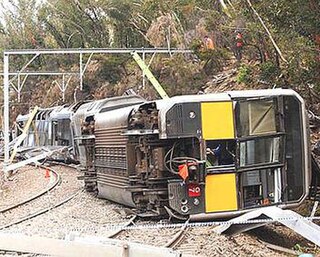
The Waterfall rail accident was a train accident that occurred on 31 January 2003 near Waterfall, New South Wales, Australia. The train derailed, killing seven people aboard, including the train driver. The accident is famously remembered by systems engineers due to the poorly designed safety systems.

The Sunshine rail disaster occurred on 20 April 1908 at the junction at Sunshine railway station when a Melbourne-bound train from Bendigo collided with the rear of a train from Ballarat. 44 people were killed and over 400 injured, almost all of them from the Ballarat train, as the Bendigo train was cushioned by its two locomotives.
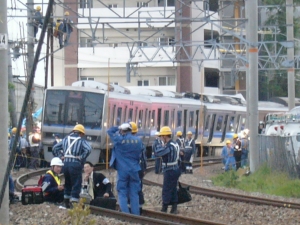
The Amagasaki derailment occurred in Amagasaki, Hyōgo Prefecture, Japan, on 25 April 2005 at 09:19 local time, just after the local rush hour. It occurred when a seven-car commuter train came off the tracks on West Japan Railway Company's Fukuchiyama Line in just before Amagasaki on its way for Dōshisha-mae via the JR Tōzai Line and the Gakkentoshi Line, and the front two cars rammed into an apartment building. The first car slid into the first-floor parking garage and as a result took days to remove, while the second slammed into the corner of the building, being crushed into an L-shape against it by the weight of the remaining cars. Of the roughly 700 passengers on board at the time of the crash, 106 passengers, in addition to the driver, were killed and 562 others injured. Most survivors and witnesses claimed that the train appeared to have been travelling too fast. The incident was Japan's most serious since the 1963 Tsurumi rail accident.
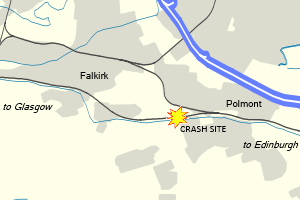
The Polmont rail accident, also known as the Polmont rail disaster, occurred on 30 July 1984 to the west of Polmont, near Falkirk, in Scotland. A westbound push-pull express train travelling from Edinburgh to Glasgow struck a cow which had gained access to the track through a damaged fence from a field near Polmont railway station, causing all six carriages and the locomotive of the train to derail. 13 people were killed and 61 others were injured, 17 of them seriously. The accident led to a debate about the safety of push-pull trains on British Rail.

The Staplehurst rail crash was a derailment at Staplehurst, Kent, on 9 June 1865 at 3:13 pm. The South Eastern Railway Folkestone to London boat train derailed while crossing a viaduct where a length of track had been removed during engineering works, killing ten passengers and injuring forty. In the Board of Trade report it was found that a man had been placed with a red flag 554 yards (507 m) away but the regulations required him to be 1,000 yards (910 m) away and the train had insufficient time to stop.

On the evening of 4 December 1957, two trains crashed in dense fog on the South Eastern Main Line near Lewisham in south-east London, causing the deaths of 90 people and injuring 173. An electric train to Hayes had stopped at a signal under the bridge, and the following steam train to Ramsgate crashed into it, destroying a carriage and causing the bridge to collapse onto the steam train. The bridge had to be completely removed; it was over a week before the lines under the bridge were reopened, and another month before the bridge was rebuilt and traffic allowed over it.
The Karanjadi train crash was an accident resulting in derailment of a passenger train at Karanjadi, a village in Maharashtra, India, on 17 June 2004. 20 people were killed and well over 100 injured in the crash, which was the result of heavy monsoon rains.
There have been a number of train accidents on the railway network of Victoria, Australia. Some of these are listed below.
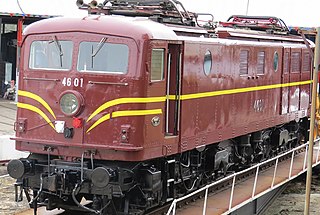
The New South Wales 46 class was a class of mainline electric locomotive built by Metropolitan-Vickers and its partner Beyer, Peacock & Company in England for the Department of Railways New South Wales. They later operated for the Public Transport Commission, State Rail Authority and FreightCorp with most remaining in service into the 1990s.
The railways of New South Wales, Australia have had many incidents and accidents since their formation in 1831. There are close to 1000 names associated with rail-related deaths in NSW on the walls of the Australian Railway Monument in Werris Creek. Those killed were all employees of various NSW railways. The details below include deaths of employees and the general public.
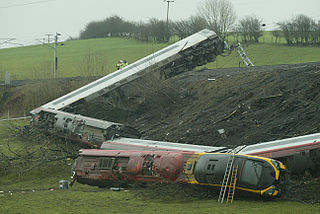
The Grayrigg derailment was a fatal railway accident that occurred at approximately 20:15 GMT on 23 February 2007, just to the south of Grayrigg, Cumbria, in the North West England region of the United Kingdom. The accident investigation concluded that the derailment was caused by a faulty set of points on the Down Main running line, controlled from Lambrigg ground frame. The scheduled inspection on 18 February 2007 had not taken place and the faults had gone undetected.
The Rometta Marea derailment occurred on Saturday 20 July 2002 in Rometta Marea, part of the Rometta comune in Sicily, Italy.
The Crevalcore train crash was a major railway accident which occurred on 7 January 2005 on the Verona–Bologna railway, Italy, killing 17. It was one of the worst accidents in the recent history of the state railway company Ferrovie dello Stato. In the accident, a cargo and a passenger train collided in dense fog after the passenger train's driver passed two red signals, possibly as a result of an unwarranted assumption by the driver that the line was clear, despite the warning signals.
This is a list of significant railway accidents in Queensland, Australia.

On 20 November 2016, the Indore–Patna Express 19321, a scheduled train from Indore to Patna, derailed near Pukhrayan, Kanpur, India, resulting in the death of 150 passengers and injuries to at least another 150.

On 20 February 2020, a NSW TrainLink XPT passenger train derailed while passing through a turnout at Wallan, Victoria, Australia. Of the 162 total on board, there were two fatalities and 61 passengers were injured, eight of whom sustained serious injuries.















